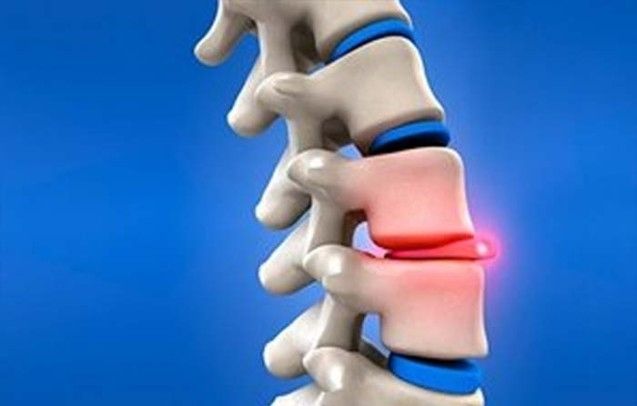 European Sports Traumatology and Orthopaedics Clinic (ECSTO)specializes in the diagnosis and treatment of diseases of the musculoskeletal system. Qualified specialists, modern equipment, the latest achievements in orthopedics and traumatology, compliance with European and international standards, round–the-clock medical care - all this makes ECSTO one of the best trauma clinics in Russia It allows Russia to successfully carry out complex operations.
European Sports Traumatology and Orthopaedics Clinic (ECSTO)specializes in the diagnosis and treatment of diseases of the musculoskeletal system. Qualified specialists, modern equipment, the latest achievements in orthopedics and traumatology, compliance with European and international standards, round–the-clock medical care - all this makes ECSTO one of the best trauma clinics in Russia It allows Russia to successfully carry out complex operations.Schmorl's hernia and its treatment
 European Sports Traumatology and Orthopaedics Clinic (ECSTO)specializes in the diagnosis and treatment of diseases of the musculoskeletal system. Qualified specialists, modern equipment, the latest achievements in orthopedics and traumatology, compliance with European and international standards, round–the-clock medical care - all this makes ECSTO one of the best trauma clinics in Russia It allows Russia to successfully carry out complex operations.
European Sports Traumatology and Orthopaedics Clinic (ECSTO)specializes in the diagnosis and treatment of diseases of the musculoskeletal system. Qualified specialists, modern equipment, the latest achievements in orthopedics and traumatology, compliance with European and international standards, round–the-clock medical care - all this makes ECSTO one of the best trauma clinics in Russia It allows Russia to successfully carry out complex operations.Many patients who apply to the European Clinic of Sports Traumatology and Orthopedics are concerned about the Schmorl hernias found on X-rays or MRI examinations performed for back pain.
The spinal column is a "tower" of vertebrae that are connected to each other by faceted joints and intervertebral discs. The intervertebral disc consists of a dense outer part and a jelly–like center - the core, which acts as a shock absorber between the vertebrae. The nucleus is separated from the bony part of the vertebrae by a cartilaginous plate.
A significant vertical load is placed on the intervertebral discs. Under certain circumstances, such as weakening of bone tissue (osteoporosis), long-term postural disorders, acute injuries (especially with excessive vertical load on the spinal column), the jelly-like core can "push through" the cartilage and bone plates and partially penetrate into the vertebral body. An indentation is formed at the border of the vertebra and disc, which is called a Schmorl hernia.
Since normally the nucleus of the disc and the bone tissue of the vertebra are isolated from each other, when a large Schmorl hernia forms in the spine, an immune reaction may occur, accompanied by severe pain. In this case, adequate anti-inflammatory and analgesic therapy is recommended. After pain relief to an acceptable level, it is recommended rehabilitation therapy under the guidance of a rehabilitologist to restore full spinal column function. Schmorl's hernia treatment includes electrotherapy, massage, and physical therapy. A prerequisite for successful treatment is the careful implementation of specialist recommendations, such as swimming, performing an individually selected set of exercises and correcting the patient's athletic activity. It is also necessary to be monitored by a neurosurgeon, since in case of insufficient effect of conservative treatment of Schmorl's hernia, surgical intervention may be required, which, however, is very rare.
In the case of multiple Schmorl hernias, the vertebra may deform, which leads to a violation of the mechanics of the spinal column. This happens quite rarely and is often associated with long-term pathological conditions (disorders of bone development, systemic diseases, severe osteoporosis, etc.). The treatment of such patients requires an interdisciplinary approach, which will be provided by qualified specialists of our clinic.
In the vast majority of cases, Schmorl's hernia is an X-ray finding during routine examinations of the spinal column and is not the cause of complaints of back pain, so there are no specific symptoms indicating the presence of this disease. To determine the cause of your complaints, you need a comprehensive examination using not only modern equipment, but also a huge amount of knowledge from specialists of the European Clinic of Sports Traumatology and Orthopedics.
During the diagnosis and treatment of diseases of the musculoskeletal system, including Schmorl's vertebral hernia, the patient of the ESCTO clinic will be provided with the most comfortable conditions, the most modern equipment will be used and advanced treatment methods with high efficiency will be applied.
Make an appointment for a consultation and we will contact you for more details
Why the EMC
The first and only clinic in Russia, created in the image of the world's leading clinics
EMC is a multidisciplinary center offering patients a high level of medical services and a personalized approach
Worldwide recognition and awards
 Learn more
Learn more
Worldwide recognition and awards
 Certificates and licenses
Certificates and licenses
Make an appointment for a consultation
Specify your contacts and we will contact you to clarify the details
and new products of the EMC












.webp)



.webp)

